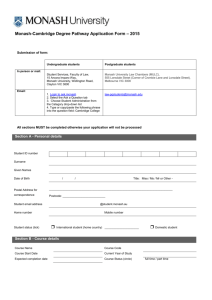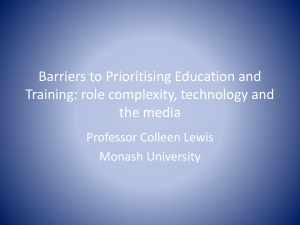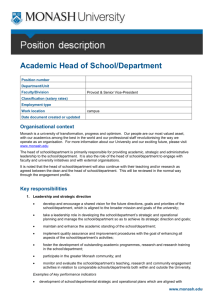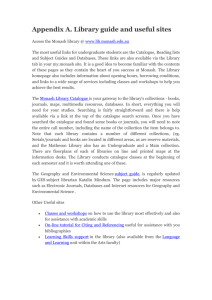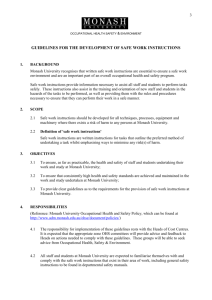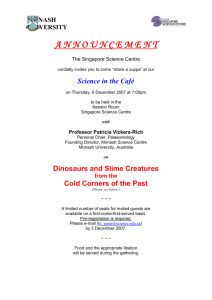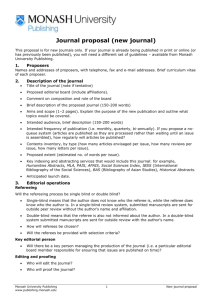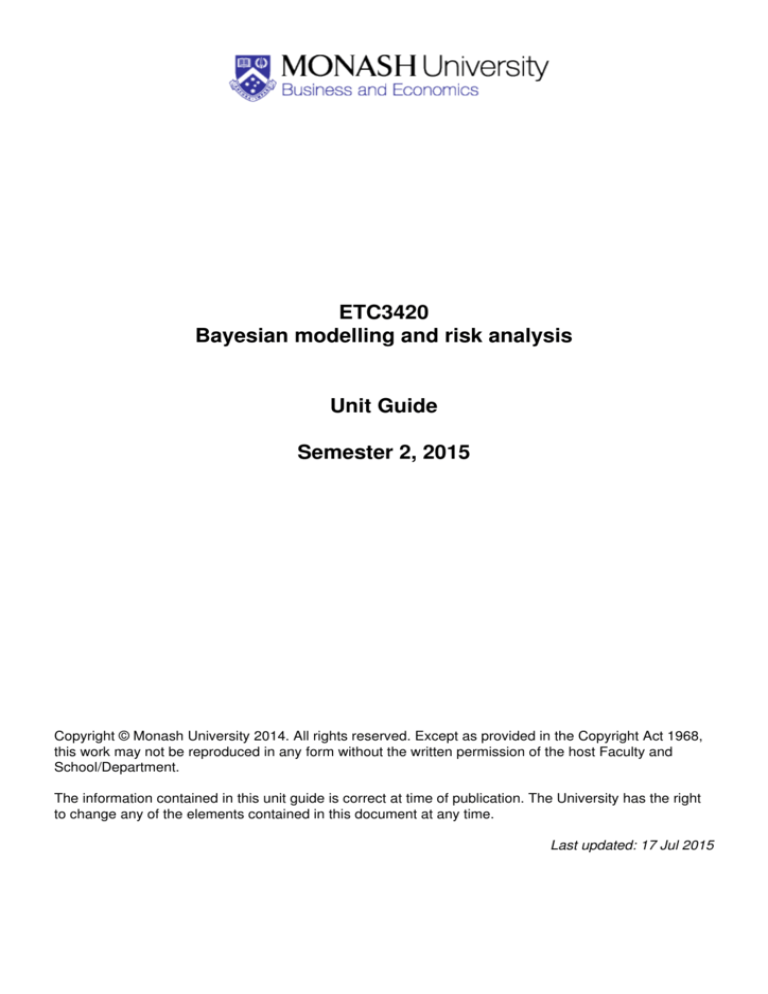
ETC3420
Bayesian modelling and risk analysis
Unit Guide
Semester 2, 2015
Copyright © Monash University 2014. All rights reserved. Except as provided in the Copyright Act 1968,
this work may not be reproduced in any form without the written permission of the host Faculty and
School/Department.
The information contained in this unit guide is correct at time of publication. The University has the right
to change any of the elements contained in this document at any time.
Last updated: 17 Jul 2015
Table of Contents
ETC3420 Bayesian modelling and risk analysis - Semester 2, 2015....................................................1
Mode of Delivery..............................................................................................................................1
Workload requirements....................................................................................................................1
Unit Relationships............................................................................................................................1
Prerequisites........................................................................................................................1
Chief Examiner(s)........................................................................................................................................1
Campus Lecturer(s).....................................................................................................................................1
Clayton.............................................................................................................................................1
Tutor(s)........................................................................................................................................................2
Clayton.............................................................................................................................................2
Your feedback to Us....................................................................................................................................2
Previous Student Evaluations of this Unit....................................................................................................2
Academic Overview...................................................................................................................................3
Learning Outcomes.........................................................................................................................3
Unit Schedule.............................................................................................................................................4
Teaching Approach..........................................................................................................................4
Assessment Summary.....................................................................................................................4
Hurdle Requirements...........................................................................................................5
Second marking...................................................................................................................5
Return of final marks............................................................................................................5
Assessment criteria..............................................................................................................5
Assessment Requirements......................................................................................................................6
Assessment Tasks...........................................................................................................................6
Participation.........................................................................................................................6
Assessment task 1...............................................................................................................6
Assessment task 2...............................................................................................................6
Examination(s).............................................................................................................................................6
Examination 1..................................................................................................................................7
Learning resources......................................................................................................................................7
Feedback to you..........................................................................................................................................7
Extensions and penalties.............................................................................................................................7
Resubmission of assignments.....................................................................................................................7
Referencing requirements...........................................................................................................................7
Assignment submission...............................................................................................................................8
Hard copy submission.....................................................................................................................8
Online submission...........................................................................................................................8
Prescribed text(s) and readings.......................................................................................................8
Recommended Resources..........................................................................................................................8
Recommended text(s) and readings................................................................................................9
Examination material or equipment.............................................................................................................9
Other Information....................................................................................................................................10
Policies..........................................................................................................................................10
Graduate Attributes Policy.................................................................................................10
Student Charter.........................................................................................................................................10
Student services........................................................................................................................................10
Monash University Library.........................................................................................................................10
Moodle 2....................................................................................................................................................11
Disability Liaison Unit................................................................................................................................11
ETC3420 Bayesian modelling and risk analysis - Semester 2,
2015
To provide a further grounding in mathematical and statistical techniques of particular relevance to
insurance and financial work.
Mode of Delivery
Clayton (Day)
Workload requirements
Minimum total expected workload to achieve the learning outcomes for this unit is 144 hours per
semester typically comprising a mixture of scheduled learning activities and independent study.
Independent study may include associated readings, assessment and preparation for scheduled
activities. The unit requires on average three/four hours of scheduled activities per week. Scheduled
activities may include a combination of teacher directed learning, peer directed learning and online
engagement.
See also Unit timetable information
Unit Relationships
Prerequisites
ETC2520 or MTH2222
Chief Examiner(s)
Dr Mike Callan
Campus Lecturer(s)
Clayton
Professor Don Poskitt
Campus: Clayton
Phone: +61 3 990 59378
Email: Donald.Poskitt@monash.edu
Dr Michael Callan
Campus: Clayton
Phone: +61 3 990 50084
Email: Mike.Callan@monash.edu
1
ETC3420 Bayesian modelling and risk analysis - Semester 2, 2015
Tutor(s)
Clayton
Mr Raveendran Menon
Campus: Caulfield
Email: Raveendran.Menon@monash.edu
Contact hours: TBA
Your feedback to Us
Monash is committed to excellence in education and regularly seeks feedback from students, employers
and staff. One of the key formal ways students have to provide feedback is through the Student
Evaluation of Teaching and Units (SETU) survey. The University’s student evaluation policy requires that
every unit is evaluated each year. Students are strongly encouraged to complete the surveys. The
feedback is anonymous and provides the Faculty with evidence of aspects that students are satisfied
and areas for improvement.
For more information on Monash’s educational strategy, see:
www.monash.edu.au/about/monash-directions/ and on student evaluations, see:
www.policy.monash.edu/policy-bank/academic/education/quality/student-evaluation-policy.html
Previous Student Evaluations of this Unit
If you wish to view how previous students rated this unit, please go to
https://emuapps.monash.edu.au/unitevaluations/index.jsp
2
Academic Overview
Learning Outcomes
The learning goals associated with this unit are to:
1. explain the concepts of decision theory and apply them
2. calculate probabilities and moments of loss distributions both with and without limits and
risk-sharing arrangements
3. construct risk models involving frequency and severity distributions and calculate the moment
generating function and the moments for the risk models both with and without simple
reinsurance arrangements
4. explain the concept of ruin for a risk model
5. explain the fundamental concepts of Bayesian statistics and use these concepts to calculate
Bayesian estimators
6. describe the fundamental concepts of risk rating and apply them to simple experience rating
systems
7. describe and apply techniques for analysing a delay (or run-off) triangle and projecting the
ultimate position
8. explain the fundamental concepts of a generalised linear model (GLM), and describe how a GLM
may apply
9. define and apply the main concepts underlying the analysis of time series models
10. explain the concepts of 'Monte Carlo' simulation using a series of pseudo-random numbers.
3
Unit Schedule
Week
Activities
Assessment
0
No formal assessment or activities are
undertaken in week 0
1
Introduction, Run-off triangles and Experience rating
2
Fitting and evaluating loss distributions
3
Reinsurance
4
Risk Models
5
Risk and Reinsurance
6
Ruin theory
7
Generalised linear models
8
Decision Theory
9
Bayesian Theory
10
Bayesian Thoery
11
Credibility theory
12
Credibility theory
Assignment 1 due
Assignment 2 due
SWOT VAC
No formal assessment is undertaken
SWOT VAC
Examination period
LINK to Assessment Policy:
http://policy.monash.edu.au/policy-bank/
academic/education/assessment/
assessment-in-coursework-policy.html
Teaching Approach
• Lecture and tutorials or problem classes
This teaching and learning approach provides facilitated learning, practical exploration and peer
learning.
• Other
Students will be responsible for some material that will not be covered in detail during lectures.
However, students are welcome to approach the lecturers and tutor with questions regarding this
material, if needed.
Assessment Summary
Within semester assessment: 30%
Examination: 70%
Assessment Task
Value
Due Date
Assignment 1
15% of overall mark
Week 6
Assignment 2
15% of overall mark
Week 11
Examination 1
70% of overall mark
To be advised
4
Unit Schedule
Hurdle Requirements
To pass this unit the student must achieve a mark of at least 40% in the final examination. Where a mark
less than 40% in the final examination is obtained, the maximum final mark will be 48%. A mark of at
least 70% is required to obtain exemption from the Actuaries Institute CT6 examination.
Second marking
Where an assessment task is given a fail grade by an examiner, that piece of work will be marked again
by a second examiner who will independently evaluate the work, and consult with the first marker. No
student will be awarded a fail grade for an assessment task or unit without a second examiner confirming
the result.
Note: Exceptions to this are individual pieces of assessment contributing 10% or less of the final mark,
unless the total of such pieces exceeds 30% of the final mark.
Return of final marks
Faculty policy states that 'the final mark that a student receives for a unit will be determined by the Board
of Examiners on the recommendation of the Chief Examiner taking into account all aspects of
assessment'.
The final mark for this unit will be released by the Board of Examiners on the date nominated in the
Faculty Calendar. Student results will be accessible through the my.monash portal.
Assessment criteria
Assessment Criteria Grading Descriptors available at:
http://www.policy.monash.edu/policy-bank/academic/education/assessment/
5
Assessment Requirements
Assessment Tasks
Participation
Students are expected to attend all lectures and tutorials. If consistent absence is required, please
discuss directly with the Chief Examiner.
•
Assessment task 1
Title:
Assignment 1
Due date:
Week 6
Details of task:
Weighting/Value:
15% of overall mark
Estimated return date:
Assessment coversheet:
Students must attach to their assignments a completed copy of the faculty Assignment
cover sheet. No assignment will be accepted or marked if it is not accompanied by a
signed Assignment cover sheet.
Additional information:
Students must retain a copy of each assignment until after they have received their final
mark for the unit.
•
Assessment task 2
Title:
Assignment 2
Due date:
Week 11
Details of task:
Weighting/Value:
15% of overall mark
Estimated return date:
Assessment coversheet:
Students must attach to their assignments a completed copy of the faculty Assignment
cover sheet. No assignment will be accepted or marked if it is not accompanied by a
signed Assignment cover sheet.
Additional information:
Students must retain a copy of each assignment until after they have received their final
mark for the unit.
Examination(s)
6
Assessment Requirements
• Examination 1
Weighting:
70% of overall mark
Length:
3 hours
Type (open/closed book):
Closed book
Electronic devices allowed in the exam:
Calculator. Any concerns regarding appropriate calculators should be directed to the Chief
Examiner.
Learning resources
Monash Library Unit Reading List (if applicable to the unit)
http://readinglists.lib.monash.edu/index.html
Feedback to you
Types of feedback you can expect to receive in this unit are:
• Informal feedback on progress in labs/tutes
• Graded assignments with comments
• Other: Students may discuss their progress directly with the Chief Examiner or other Lecturers.
Extensions and penalties
Applications for assignment extensions must be made in writing to the Chief Examiner. Approval,
if granted, will be in writing and will be recorded on the Faculty Assignment cover sheet
accompanying the assignment.
A penalty of 5% of the mark allocated to the assignment may be deducted for each day that the
assignment is late.
Resubmission of assignments
Generally not permitted without prior arrangement from the Chief Examiner.
Referencing requirements
Assignments are individual and not group assignments. They are intended to test your achievement of
the objectives of the unit. Students therefore must not collaborate or collude in completing their
assignments.
Any insights or results that come from a source other than the class material or the student who is
submitting the assignment (eg, a textbook or another individual) must be acknowledged in writing on the
assignment. Failure to appropriately reference resources may result in a penalty, including receiving a
mark of zero on the relevant assignment.
7
Assessment Requirements
Assignment submission
Hard copy submission
Students must attach to their assignments a completed copy of the faculty Assignment cover sheet. No
assignment will be accepted or marked if it is not accompanied by a signed Assignment cover
sheet.
Students must retain a copy of each assignment until after they have received their final mark for the
unit.
Online submission
Students must submit a hard copy of their assignment to the lecturer at the end of the lecture on the day
(5pm) on which the assignment is due. In addition, where Eviews work files and/or Excel spreadsheets
(or other similar software files) have been used to produce the assignment, students must submit an
electronic copy of the relevant files to the tutor. However, anything that the student wishes to be formally
regarded as part of their assignment must be submitted on paper. Otherwise, electronic submission of
assignments is not acceptable, except as explicitly indicated by the lecturer.
Prescribed text(s) and readings
No textbooks are required, however students may find the recommended materials of assistance.
Recommended Resources
There is a unit site on Blackboard. Assignment data, tutorial data and other information relevant to the
unit will be posted on this site.
Students will be provided with lecture slides, not typed lecture notes. However, all the topics discussed in
lectures are fully covered in:
• Statistical and Probabilistic Methods in Actuarial Science. Boland P. J. Chapman & Hall. 2007.
344 pages. ISBN 1584886951
The following text also covers the course, and contains many exercises:
• Core Reading for Institute of Actuaries of UK Subject CT6 Statistical Methods (available through
ActEd Sydney)
The following is a brief list of additional references that you may wish to consult:
• An introduction to Statistical Modelling. Dobson, A. J. Chapman & Hall, 1983. 125 pages. ISBN:
0412248603
• Introductory Statistics with Applications in General Insurance. Hossack, I. B.; Pollard, J. H.;
Zehnwirth, B. 2nd ed. Cambridge University Press, 1999. 282 pages. ISBN: 052165534X
The Unit lecturers may also suggest further references for specific parts of the course.
8
Assessment Requirements
Recommended text(s) and readings
1. Statistical and probabilistic methods in actuarial science. Boland P. J. Chapman & Hall. 2007. 344
pages. ISBN 1584886951.
2. Core Reading for Institute of Actuaries of UK Subject CT6 Statistical Methods (available through
ActEd Sydney).
3. An introduction to statistical modelling. Dobson, A. J. Chapman & Hall, 1983. 125 pages. ISBN:
0412248603.
4. Introductory statistics with applications in general insurance. Hossack, I. B.; Pollard, J. H.; Zehnwirth,
B. 2nd ed. Cambridge University Press, 1999. 282 pages. ISBN: 052165534X.
Examination material or equipment
A calculator is permitted during the final examination.
9
Other Information
Policies
Monash has educational policies, procedures and guidelines, which are designed to ensure that staff and
students are aware of the University’s academic standards, and to provide advice on how they might
uphold them. You can find Monash’s Education Policies at:
www.policy.monash.edu.au/policy-bank/academic/education/index.html
Key educational policies include:
• Student Academic Integrity Policy and Student Academic Integrity: Managing Plagiarism and
Collusion Procedures ;
• Assessment in Coursework Programs;
• Special Consideration;
• Grading Scale;
• Discipline: Student Policy;
• Academic Calendar and Semesters;
• Orientation and Transition; and
• Academic and Administrative Complaints and Grievances Policy.
Graduate Attributes Policy
http://www.policy.monash.edu/policy-bank/academic/
education/management/monash-graduate-attributes-policy.html
Student Charter
www.opq.monash.edu.au/ep/student-charter/monash-university-student-charter.html
Student services
The University provides many different kinds of support services for you. Contact your tutor if you need
advice and see the range of services available at http://www.monash.edu.au/students
You can also access important information from the Faculty of Business and Economics current students
page http://www.buseco.monash.edu.au/student/
Caulfield and Clayton students wishing to further develop English language skills in a fun group
environment can join a Conversational English Program. You can access these programs at
http://www.monash.edu/students/conversational-english/
Monash University Library
The Monash University Library provides a range of services, resources and programs that enable you to
save time and be more effective in your learning and research. Go to www.lib.monash.edu.au or the
library tab in my.monash portal for more information.
10
Other Information
Moodle 2
All unit and lecture materials, plus other information of importance to students, are available through the
virtual learning environment Moodle site. You can access Moodle via the my.monash portal.
Where to go for help
If you're stuck, confused or simply not sure how to approach Moodle, there are a number of Moodle
resources that you can tap into.
Disability Liaison Unit
Students who have a disability or medical condition are welcome to contact the Disability Liaison Unit to
discuss academic support services. Disability Liaison Officers (DLOs) visit all Victorian campuses on a
regular basis.
• Website: http://www.monash.edu/equity-diversity/disability/index.html
• Telephone: 03 9905 5704 to book an appointment with a DLO;
• Email: dlu@monash.edu
• Drop In: Equity and Diversity Centre, Level 1, Building 55, Clayton Campus.
11

